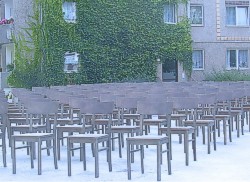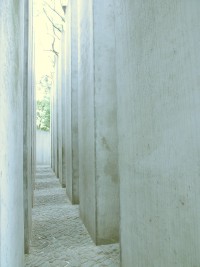UCH to its credit, reunited Germany is trying valiantly not to ignore its Nazi legacy. We saw evidence of German awareness of its recent dark past. In 2001Leipzig erected a memorial on the former site of the Great Community Synagogue. The synagogue, built in 1854, was destroyed during the November 1938 Reichspogromnacht (Kristtalnacht). There is no resurrected synagogue at the site. Several dozen lonely chairs stand on a platform in an empty lot under the open sky, as if awaiting the return of people that were driven out of the neighborhood. You stand in front of this assembly of empty seats – a powerful evocation – contemplate the carnage of Leipzig’s Jewish citizens, and shed a tear.

Where have they gone? |
In Berlin the Jewish Museum was expanded with the addition in 1999 of a multi-layered zinc-clad structure fearlessly designed by Daniel Libeskind. Access to this annex is through the adjacent old building, which brings you to corridors that slant, walls that zigzag, a solitary pathway that leads to a dead-end and, at last, an outdoor garden.
This Garden of Exile and Emigration consists of 49 pillars that serve to instill a feeling of insecurity as you navigate over the uneven ground, walking on hard cobblestones, trying to keep your balance. You are supposed to feel what German Jews felt as they were forced from their homes, divested of their citizenship, stripped of their humanity and finally removed from life itself as they were driven to the crematoria.
Do you feel their pain? I don’t think so.
As I made my way around the pillars, my thoughts were not about these people being thrown out of their homes. My thoughts were about trying to negotiate around these pillars and keep my balance on the uneven ground. Is that what Libeskind wrought?

Watch where you walk. |
Then there is the unwieldy named Memorial to the Murdered Jews of Europe. More pillars. Some are 15 feet tall. This is the city’s cumbersome commemoration of the annihilation of six million Jews of the Holocaust.
Chancellor Gerhard Schroeder will inaugurate this monstrosity on May 10. Finally Berlin will have its own Holocaust memorial and every citizen can go on with his life knowing he’s done his duty to history.
But what do you think, or feel, as you gaze at these 2,711 stark concrete slabs planted in one citywide block of prime land?
On one side is the future home of the U.S. Embassy, now under construction. Beyond is the imposing Brandenburg Gate. A stone’s throw south is the site of Hitler’s bunker. That’s what I envision when I stand before the Memorial to the Murdered Jews of Europe.

Does this move you? |
Walking among these pillars, you shudder from claustrophobia rather than from the realization of mass murder. Surely that was not the intent. Viewed from above, these concrete pillars look like a mass of gravestones. If that was the intent of architect Peter Eisenman, then it should have been constructed as a high-tech cemetery that would evoke a tear at the memory of those millions murdered.
Pillars on shaky ground, concrete columns – such "monuments" cannot possibly evoke memory of the Holocaust, elicit a tear for the victims, or conjure the resolve of "Never again!"
Learn from Pol Pot’s massacre of his Cambodian people. Concrete pillars will not move your heart. Dig an open grave, pile up the skeletons at the mouth of the pit, let the locals and tourists gaze at the horror – that would be a fitting Memorial to the Murdered Jews of Europe.